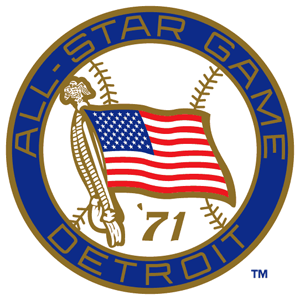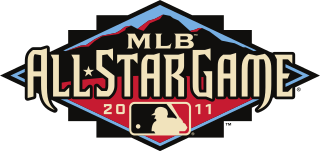Related Research Articles

In baseball, a home run is scored when the ball is hit in such a way that the batter is able to circle the bases and reach home plate safely in one play without any errors being committed by the defensive team. A home run is usually achieved by hitting the ball over the outfield fence between the foul poles without the ball touching the field.

The Major League Baseball All-Star Game, also known as the "Midsummer Classic", is an annual professional baseball game sanctioned by Major League Baseball (MLB) and contested between the all-stars from the American League (AL) and National League (NL). Starting fielders are selected by fans, pitchers are selected by managers, and reserves are selected by players and managers.

Thomas Henry Connolly was an English-American umpire in Major League Baseball. He officiated in the National League from 1898 to 1900, followed by 31 years of service in the American League from 1901 to 1931. In over half a century as an American League umpire and supervisor, he established the high standards for which the circuit's arbiters became known, and solidified the reputation for integrity of umpires in the major leagues.

The 1918 World Series was the championship series in Major League Baseball for the 1918 season. The 15th edition of the World Series, it matched the American League champion Boston Red Sox against the National League champion Chicago Cubs. The Red Sox beat the Cubs four games to two. The Series victory for the Red Sox was their fifth in five tries, going back to 1903. The Red Sox scored only nine runs in the entire Series, the fewest runs by the winning team in World Series history. Along with the 1906 and 1907 World Series, the 1918 World Series is one of only three Fall Classics where neither team hit a home run.

The 1926 World Series was the championship series of the 1926 Major League Baseball season. The 23rd edition of the Series, it pitted the National League champion St. Louis Cardinals against the American League champion New York Yankees. The Cardinals defeated the Yankees four games to three in the best-of-seven series, which took place from October 2 to 10, 1926, at Yankee Stadium and Sportsman's Park.
The 1930 World Series featured the defending World Series champion Philadelphia Athletics against the National League (NL) champion St. Louis Cardinals. The Athletics defeated the Cardinals in six games, 4–2. Philadelphia's pitching ace Lefty Grove, and George Earnshaw, the No. 2 man in Mack's rotation, won two games apiece. Earnshaw also pitched seven scoreless innings as Game 5 starter, but ended up with a no-decision as Grove relieved him in the eighth and took the win on Jimmie Foxx's two-run homer in the top of the ninth for the game's only scoring.
The 1932 World Series was the championship series in Major League Baseball for the 1932 season. The 29th edition of the World Series, it matched the American League champion New York Yankees versus the National League champions Chicago Cubs. The Yankees won in a four-game sweep. By far its most noteworthy moment was Babe Ruth's "called shot" home run, in his 10th and last World Series. It was punctuated by fiery arguments between the two teams, heating up the atmosphere before the World Series even began. A record 13 future Hall of Famers played in this World Series, with three other future Hall of Famers also participating: umpire Bill Klem, Yankees manager Joe McCarthy, and Cubs manager Rogers Hornsby. It was also the first World Series in which both teams wore uniforms with numbers on the backs of the shirts.
The following are the baseball events of the year 2000 throughout the world.

Lonnie Warneke, nicknamed "The Arkansas Hummingbird", was a Major League Baseball player, Major League umpire, county judge, and businessman from Montgomery County, Arkansas, whose career won-loss record as a pitcher for the Chicago Cubs and St. Louis Cardinals (1937–42) was 192–121.

The 2002 Major League Baseball All-Star Game was the 73rd playing of the midsummer classic between the all-stars of the American League (AL) and National League (NL), the two leagues that make up Major League Baseball. The game was held on July 9, 2002 at Miller Park, now named American Family Field, in Milwaukee, Wisconsin, the home of the Milwaukee Brewers of the NL. The game controversially ended with a 7–7 tie due to both teams running out of available pitchers. Beginning the next year, home field advantage in the World Series would be awarded to the winning league to prevent ties.

The 1983 Major League Baseball All-Star Game was the 54th edition of the midsummer classic between the all-stars of the American League (AL) and National League (NL), the two leagues comprising Major League Baseball. The game was held on July 6 at Comiskey Park in Chicago, Illinois, the home of the Chicago White Sox of the American League. The Wednesday night game resulted in a 13–3 American League victory. The game celebrated the fiftieth anniversary of the All-Star Game, and occurred exactly 50 years to the date of the first All-Star game, also at Comiskey Park. This was the 54th game, as no game was held in 1945, while two were held each year from 1959 through 1962.
The 1989 Major League Baseball season saw the Oakland Athletics win their first World Series title since 1974.

The 1941 Major League Baseball All-Star Game was the ninth playing of the mid-summer classic between the all-stars of the American League (AL) and National League (NL), the two leagues comprising Major League Baseball. The game was held on July 8, 1941, at Briggs Stadium in Detroit, Michigan, the home of the Detroit Tigers of the American League.

The 1973 Major League Baseball All-Star Game was the 44th midseason exhibition between the all-stars of the American League (AL) and the National League (NL), the two leagues comprising Major League Baseball. The game was played on July 24, 1973, at Royals Stadium in Kansas City, Missouri, home of the Kansas City Royals of the American League. The game resulted in a 7–1 victory for the NL.

The 1967 Major League Baseball All-Star Game was the 38th midseason exhibition between the all-stars of the American League (AL) and the National League (NL), the two leagues comprising Major League Baseball. The game was played on July 11, 1967, at Anaheim Stadium in Anaheim, California, home of the California Angels of the American League. The game resulted in a 2–1 15 inning victory for the NL. It set the record for the longest All-Star Game by innings, matched in 2008.

The 1971 Major League Baseball All-Star Game, the 42nd edition, was played on Tuesday, July 13. The all-stars from the American League and the National League faced each other at Tiger Stadium, home of the Detroit Tigers, and the home team AL won 6–4.

The 2011 Major League Baseball All-Star Game was the 82nd in-season exhibition game between the All-Stars of the National League (NL) and the American League (AL); the leagues composing Major League Baseball. The event was held on Tuesday, July 12, 2011 at Chase Field in Phoenix, Arizona, home of the National League Arizona Diamondbacks. The game ended in a 5–1 win for the National League, their second straight All-Star victory. It was the first MLB All-Star Game to be held in Arizona and the first in a National League Park to have a designated hitter.
The 1950 Major League Baseball All-Star Game was the 17th playing of the midsummer classic between the all-stars of the American League (AL) and National League (NL), the two leagues comprising Major League Baseball. The game was held on July 11, 1950, at Comiskey Park in Chicago the home of the Chicago White Sox of the American League. The game resulted in the National League defeating the American League 4–3 in 14 innings. It was the first All-Star game to go into extra innings.
The 1947 Major League Baseball All-Star Game was the 14th playing of the "Midsummer Classic" between Major League Baseball's (MLB) American League (AL) and National League (NL) All-Star teams. The All-Star Game was held on July 8, 1947, at Wrigley Field in Chicago, the home of the NL's Chicago Cubs.

The Addie Joss Benefit Game was an exhibition baseball game played between the Cleveland Naps of the American League and an all-star team composed of players from the league's other teams at League Park in Cleveland, Ohio, on July 24, 1911. The game was planned as a benefit for the family of Addie Joss, a pitcher for the Naps who died in April. The all-stars defeated the Naps, 5–3, and the game raised $12,914 for the Joss family.
References
- ↑ "1933 All-Star Game Box Score, July 6". Baseball-Reference.com .
- ↑ "Addie Joss All-Star Game". Baseball Almanac . Retrieved August 4, 2015.
- ↑ Husman, John R. "Addie Joss Day: An All-Star Celebration". Society for American Baseball Research. Retrieved May 19, 2021.
- ↑ This Day In History, July 6, 1933 Retrieved Aug 2, 2015
- ↑ This Day In History, July 6, 2015 Retrieved Aug 2, 2015
- ↑ Baseball Chronology, 1933 Baseball All-Star Game Retrieved August 2, 2015